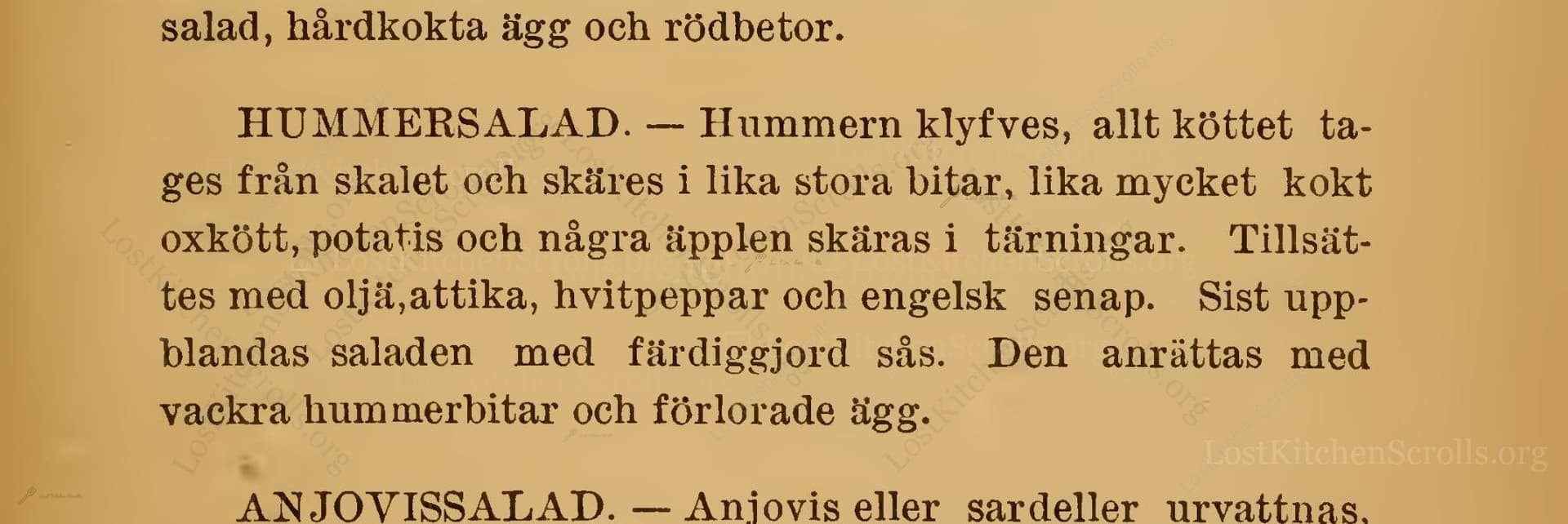Hummersalad
"Lobster Salad"
From the treasured pages of Praktisk, illustrerad kok-bok för Svenskarne i Amerika
Written by C. A. (Charles A.) Vallentin

Hummersalad
"Hummern klyfves, allt köttet tages från skalet och skäres i lika stora bitar, lika mycket kokt oxkött, potatis och några äpplen skäras i tärningar. Tillsättes med olja, ättika, hvitpeppar och engelsk senap. Sist upp-blandas saladen med färdiggjord sås. Den anrättas med vackra hummerbitar och förlorade ägg."
English Translation
"LOBSTER SALAD. — The lobster is split, all the meat is taken from the shell and cut into equal-sized pieces; an equal amount of cooked beef, potatoes, and some apples are cut into cubes. Mix with oil, vinegar, white pepper and English mustard. Finally, the salad is mixed with prepared sauce. It is garnished with beautiful pieces of lobster and poached eggs."
Note on the Original Text
The recipe is written in a succinct, direct style, assuming the reader's basic cooking knowledge and experience with ingredient handling. Spelling and phrasing, such as 'hummern klyfves' (the lobster is split) and 'upp-blandas' (mixed in), are typical of late 19th-century Swedish, before spelling reforms. The measured quantities are implicit, revealing a trust in the cook’s intuition and sensibility, rather than modern precision. Seasonings (oil, vinegar, mustard) were commonly measured to taste, and the instruction to use a 'färdiggjord sås' (prepared sauce) hints at the nascent convenience culture emerging in American kitchens.

Title
Praktisk, illustrerad kok-bok för Svenskarne i Amerika (1889)
You can also click the book image above to peruse the original tome
Writer
C. A. (Charles A.) Vallentin
Era
1889
Publisher
Svenska bok-och musikhandelns förlag
Background
A practical and charmingly illustrated Swedish cookbook tailored for immigrants in America, this 1889 volume serves up a delightful array of recipes and culinary wisdom, blending Old World tradition with New World ingredients.
Kindly made available by
Library of Congress
This lobster salad recipe was first published in 1889 in Minneapolis for a growing community of Swedish immigrants adapting old-world flavors to new-world ingredients. The cookery book sought to bridge Swedish traditions with contemporary American foodways, offering practical, illustrated guidance for everyday households. Dishes like "Hummersalad" were festive fare, showing off both culinary nostalgia and local abundance: Scandinavian fondness for seafood meets Midwestern bounty. Lobster, once an affordable luxury, frequently graced celebratory tables for both Swedish aristocrats and prosperous American Swedes.

In the late 19th century, lobster would have been split using a heavy kitchen knife or cleaver. Boiled beef and potatoes were chopped by hand with large, sturdy knives on simple wooden boards. Ingredients were mixed in ceramic or earthenware bowls and dressed using spoons or wooden paddles. For poaching eggs, cooks used wide, shallow pans over wood or coal-fired stoves. Serving platters ranged from simple earthenware to elegant pressed glass, with presentation emphasizing color and visual appeal.
Prep Time
25 mins
Cook Time
10 mins
Servings
4
We've done our best to adapt this historical recipe for modern kitchens, but some details may still need refinement. We warmly welcome feedback from fellow cooks and culinary historians — your insights support the entire community!
Ingredients
- 1 cooked lobster (about 18 oz in shell, yielding approx. 7 oz meat)
- 7 oz cooked beef (such as brisket or rump)
- 7 oz boiled potatoes
- 2 medium apples (about 5 oz each), firm and tart (e.g., Granny Smith)
- 3 tbsp neutral oil (such as rapeseed or sunflower)
- 1.5 tbsp white vinegar
- 0.5 tsp ground white pepper
- 1 tbsp English mustard
- 6 tbsp ready-made salad sauce (mayonnaise or remoulade)
- 2-4 poached eggs, for garnish
Instructions
- Begin by splitting a cooked lobster in half and remove all the meat from the shell.
- Cut the lobster meat into equally sized pieces.
- Do the same with boiled beef (such as brisket or rump), as well as boiled potatoes and some crisp apples – all should be diced into small, uniform cubes.
- In a large bowl, gently mix these ingredients together.
- Dress everything with a generous drizzle of neutral oil (such as rapeseed or sunflower), a splash of white vinegar, a good grind of white pepper, and a spoonful of English mustard.
- Just before serving, fold the mixture with a ready-made salad sauce (a simple mayonnaise or remoulade works beautifully today).
- Arrange the salad on a platter, garnished with decorative lobster pieces and "poached eggs" (traditionally, soft poached eggs on top).
- Serve immediately, while the components are still fresh and vibrant.
Estimated Calories
450 per serving
Cooking Estimates
Preparation includes dicing the lobster, beef, potatoes, and apples, mixing the salad, and poaching eggs if desired. Most ingredients are pre-cooked, so only a little time is needed to bring everything together. Calories are estimated per serving.
As noted above, we have made our best effort to translate and adapt this historical recipe for modern kitchens, taking into account ingredients nowadays, cooking techniques, measurements, and so on. However, historical recipes often contain assumptions that require interpretation.
We'd love for anyone to help improve these adaptations. Community contributions are highly welcome. If you have suggestions, corrections, or cooking tips based on your experience with this recipe, please share them below.
Join the Discussion
Rate This Recipe
Dietary Preference
Main Ingredients

Den Bockfisch In Einer Fleisch Suppen Zu Kochen
This recipe hails from a German manuscript cookbook compiled in 1696, a time whe...

Die Grieß Nudlen Zumachen
This recipe comes from a rather mysterious manuscript cookbook, penned anonymous...

Ein Boudain
This recipe comes from an anonymous German-language manuscript cookbook from 169...

Ein Gesaltzen Citroni
This recipe, dating from 1696, comes from an extensive anonymous German cookbook...
Browse our complete collection of time-honored recipes



